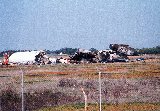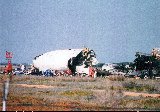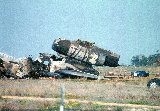 2500m visibility; thunderstorms with 3/8 clouds at 500ft, 7/8 clouds at 2300ft and 1/8 cumulonimbus at 2500ft, temp. 16deg. C. Clearance to descend to 1220m was given at 08.20h, followed by a clearance to 915m and 650m 4, resp. 6 minutes later. At 08.29 the crew were informed that the runway was flooded. At an altitude of 303m and 140kts speed the approach became unstable and at 177m the first officer switched the autopilot from CMD (command mode) to CWS (control-wheel steering). One minute later it was switched from CWS
2500m visibility; thunderstorms with 3/8 clouds at 500ft, 7/8 clouds at 2300ft and 1/8 cumulonimbus at 2500ft, temp. 16deg. C. Clearance to descend to 1220m was given at 08.20h, followed by a clearance to 915m and 650m 4, resp. 6 minutes later. At 08.29 the crew were informed that the runway was flooded. At an altitude of 303m and 140kts speed the approach became unstable and at 177m the first officer switched the autopilot from CMD (command mode) to CWS (control-wheel steering). One minute later it was switched from CWS  to mamual and the airspeed began falling below approach reference speed. About 3-4 seconds short of touchdown elevator was pulled to pitch up and engine power was increased. When the no.3 and 5 spoilers extended, the aircraft had a 25deg. bank, left wing up. The right maingear contacted the runway with a 900ft/min descent rate at 126kts, +8.79deg. pitch up, +5.62deg roll and 1,9533G. The right wing separated while the aircraft slid down the runway. The aircraft came to rest 1100m from the Runway 11 threshold and 100m to the right of the centerline and caught fire. PROBABLE CAUSES: "The high rate of descent in the final phase of the approach and the landing made on the right landing gear, which exceeded the structural limitations of the aircraft.; The crosswind, which exceeded the aircrafts limits and which occurred in the final phase of the approach and during landing. The combination of both factors determined stresses which exceeded the structural limitations of the aircraft. Contributing factors were: The instability of the approach; the premature power reduction, and the sustaining of this condition, pribably due to crew action; the incorrect wind information delivered by Approach Control; the absence of an approach light system; the incorrect evaluation by the crew of the runway conditions; CWS mode being
to mamual and the airspeed began falling below approach reference speed. About 3-4 seconds short of touchdown elevator was pulled to pitch up and engine power was increased. When the no.3 and 5 spoilers extended, the aircraft had a 25deg. bank, left wing up. The right maingear contacted the runway with a 900ft/min descent rate at 126kts, +8.79deg. pitch up, +5.62deg roll and 1,9533G. The right wing separated while the aircraft slid down the runway. The aircraft came to rest 1100m from the Runway 11 threshold and 100m to the right of the centerline and caught fire. PROBABLE CAUSES: "The high rate of descent in the final phase of the approach and the landing made on the right landing gear, which exceeded the structural limitations of the aircraft.; The crosswind, which exceeded the aircrafts limits and which occurred in the final phase of the approach and during landing. The combination of both factors determined stresses which exceeded the structural limitations of the aircraft. Contributing factors were: The instability of the approach; the premature power reduction, and the sustaining of this condition, pribably due to crew action; the incorrect wind information delivered by Approach Control; the absence of an approach light system; the incorrect evaluation by the crew of the runway conditions; CWS mode being  switched off at approx. 80ft RA, causing the aircraft to be in manual control in a critical phase of the landing; the delayed action of the crew in increasing power; the degradation of the lift coefficient due to heavy showers." (DGAC Portugal) The Netherlands Aviation Safety Board commented that the probable cause should read: "a sudden and unexpected windvariation in direction and speed (windshear) in the final stage of the approach. Subsequently a high rate of descent and an extreme lateral displacement developed, causing a hard landing on the righthand maingear, which in combination with a considerable crabangle exceeded the aircraft structural limitations. Contributing factors: From the forecast and the prevailing weather the crew of MP495 did not expect the existance of windshear phenomena.; The premature large power reduction and sustained flight idle thrust, most probable due to crew action.; CWS mode being disengaged at approx. 80ft RA, causing the aircraft to be in manual control at a critical stage in the landing phase.".
switched off at approx. 80ft RA, causing the aircraft to be in manual control in a critical phase of the landing; the delayed action of the crew in increasing power; the degradation of the lift coefficient due to heavy showers." (DGAC Portugal) The Netherlands Aviation Safety Board commented that the probable cause should read: "a sudden and unexpected windvariation in direction and speed (windshear) in the final stage of the approach. Subsequently a high rate of descent and an extreme lateral displacement developed, causing a hard landing on the righthand maingear, which in combination with a considerable crabangle exceeded the aircraft structural limitations. Contributing factors: From the forecast and the prevailing weather the crew of MP495 did not expect the existance of windshear phenomena.; The premature large power reduction and sustained flight idle thrust, most probable due to crew action.; CWS mode being disengaged at approx. 80ft RA, causing the aircraft to be in manual control at a critical stage in the landing phase.".Photos by Paulo Carvalho